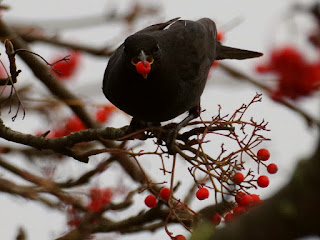Jays can remember the position of thousands of caches of nuts.
A Carrion Crow had made no such preparations, and was looking for worms in a flower bed in the Rose Garden.
The Blackbirds in the rowan trees on Buck Hill were gathering fruit. Supplies are beginning to run low.
There are reports of flocks of Waxwings arriving on the east coast, but by the time they reach London these berries will be gone.
This Black-Headed Gull had won a piece of cake, and sped away to devour it.
If a gull is lucky enough to get a bit of food, there is usually a wild flurry of other gulls trying to get it. The young Herring Gull at the top of the picture managed to hang on to its bit of Arab flatbread.
Another was diving energetically into the Serpentine.
It came up with a stone to play with.
Others had more unusual toys -- a strangely shaped bit of red plastic ...
... and an equally mysterious green bit.
These two Herring Gulls had picked up leaves, but not as toys. They were a pair waving them at each other in a bonding ritual. Every so often they would put down the leaves and call to each other.
The pigeon-eating Lesser Black-Backed Gull has a slight injury to his face. Evidently his lunch fought back.
There were a good number of Shovellers at the Vista, but not quite the magic number to start them forming one of their grand circles, which is about fifty.
So they had to revolve on their own. How do they avoid getting dizzy?
This is just an ordinary Moorhen on a rock in the Dell, but the light was pretty.













Shovellers defy dizziness as much as Coots defy common sense, I guess. It is in their nature to deny common laws of the universe.
ReplyDeleteI think your blog would be an invaluable resource to study Gulls' play behaviour. There is such a wealth of pictures and observations just begging to be studied.
The bird that did that to the Pigeon-Killing Fellow must have been a very strappy pigeon!
I suppose Shovellers have some magic modification to their inner ear that allows them to resist giddiness. There is probably a small but perfectly formed PhD thesis in this.
DeleteCompletely unrelated to all of the above, but I just thought I might draw on the collective wisdom of all your blog's admirers: is there any bird name in English that calls a small bird by the name of a large bird, or viceversa? Like in Spanish 'buitrón', which means 'great vulture', for the diminutive zitting cisticola, or strouthos in Attic Greek for the ostrich.
ReplyDeleteI've been thinking and looking at the index of the Collins Bird Guide, and can't think of any examples. The ancient Greek use of στρουθός to mean both a sparrow and an ostrich my be a joke: having seen sparrows and then being confronted by these enormous African creatures, they called them 'sparrows' much as you would call a very tall man 'Shorty'. The Liddell and Scott entry at least shows the amazing vagueness of the ancients about species:
DeleteΣΤΡΟΥΘΟ´Σ, ὁ, also ἡ, any small bird, esp. a sparrow. II. any bird. as an eagle: -- ὁ μέγας στρουθός the large bird, the ostrich, called στρουθός κατάγαιος from its running along the ground: also simply στρουθός (ἡ).
A vague hint here that στρουθός meaning a sparrow was usually masculine, and στρουθός meaning an ostrich was at least sometimes feminine, cf. Spanish rata = rat and ratón = mouse.
Thank you so very much for this; I hadn't thought of the gender difference, but it's clear that you are on to something there. This bears investigation!
DeleteI had been thinking about the sparrows that appear in Aeschylus's Agamemnon 145:δεξιὰ μὲν, κατάμομφα δὲ φάσματα †στρουθῶν† Some think στρουθῶν might mean 'eagle', but I don't think that's possible. Yet others think they are the sparrows from the cruel portent of the sparrows and the serpent in Iliad 2. I can't see why they would intrude in the text, be it that Aeschylus himself wrote it, or that a scribe did the deed. A conundrum if there ever was one.
On the other hand it may be a complete coincidence. It was just an idle thought. I can't think of any other examples.
DeleteI'd have thought the 'Great Tit' counted as quite small in any size-ranking? Further to the vagueness of Liddell & Scott, I recommend D'Arcy Wentworth Thompson's 1895 'Glossary of Greek Birds'; he opens with the splendidly apt mission-statement that "Instead of [attempting] to identify a greater number of species than other naturalist-commentators [...] have done, I have on the contrary ventured to identify a great many less." He explains: "This limitation on my part is chiefly due to the circumstance that I have not ventured to use for purposes of identification a large class of statements on which others have more or less confidently relied." - e.g. proverbs, etc.
ReplyDeleteThe book is findable online at https://archive.org/details/glossaryofgreekb00thomrich
Thanks for the information about the book -- will have a look at it.
DeleteWhat Thompson accomplished was truly a labour of Hercules. His books on ancient Greek fauna have been compulsory reading until very very recently, and I still know of colleagues who use it in preference to G. W. Arnott (who was the better birder).
Delete